
It's a story on how to write a plugin for Unity Asset Store, take a crack at solving the well-known isometric problems in games, and make a little coffee money from that, and also to understand how expandable Unity editor is. Pictures, code, graphs and thoughts inside.
Prologue
So, it was one night when I found out I had got pretty much nothing to do. The coming year wasn't really promising in my professional life (unlike personal one, though, but that's a whole nother story). Anyway, I got this idea to write something fun for old times sake, that would be quite personal, something on my own, but still having a little commercial advantage (I just like that warm feeling when your project is interesting for somebody else, except for your employer). And all this went hand in hand with the fact that I have long awaited to check out the possibilities of Unity editor extension and to see if there's any good in its platform for selling the engine's own extensions.
I devoted one day to studying the Asset Store: models, scripts, integrations with various services. And first it seemed like everything has already been written and integrated, having even a number of options of different quality and detail levels, just as much as prices and support. So right away I've narrowed it down to:
- code only (after all, I'm a programmer)
- 2D only (since I just love 2D and they've just made a decent out-of-the-box support for that in Unity)
And then I remembered just how many cactuses I've ate and how many mice've died when we were making an isometric game before. You won't believe how much time we've killed on searching viable solutions and how many copies we've broken in attempts to sort out this isometry and draw it. So, struggling to keep my hands still, I searched by different key and not-so-much-key words and couldn't find anything except a huge pile of isometric art, until I finally decided to make an isometric plugin from scratch.
Setting the goals
The first I need was to describe in short what problems this plugin was supposed to solve and what use the isometric games developer would make of it. So, the isometry problems are as follows:
- sorting objects by remoteness in order to draw them properly
- extension for creation, positioning and displacement of isometric objects in the editor
Thus, with the main objectives for the first version formulated, I set myself 2-3 days deadline for the first draft version. Thus couldn't being deferred, you see, since enthusiasm is a fragile thing and if you don't have something ready in the first days, there's a great chance you ruin it. And New Year holidays are not so long as the might seem, even in Russia, and I wanted to release the first version within, like, ten days.
Sorting
To put it short, isometry is an attempt made by 2D sprites to look like 3D models. That, of course, results in dozens of problems. The main one is that the sprites have to be sorted in the order in which they were to be drawn to avoid troubles with mutual overlapping.
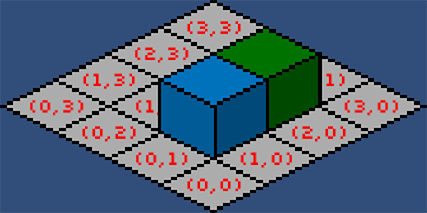
On the screenshot you can see how it's the green sprite that is drawn first (2,1), and then the blue one goes (1,1)
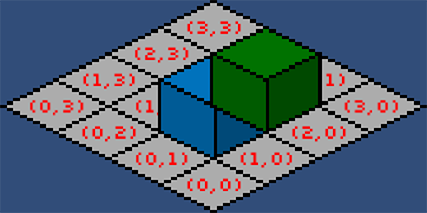
The screenshot shows the incorrect sorting when the blue sprite's drawn first
In this simple case sorting won't be such a problem, and there are going to be options, for example:
- sorting by position of Y on the screen, which is *(isoX + isoY) 0.5 + isoZ**
- drawing from the remotest isometric grid cell from left to right, from top to down [(3,3),(2,3),(3,2),(1,3),(2,2),(3,1),...]
- and a whole bunch of other interesting and not really interesting ways
They all are pretty good, fast and working, but only in case of such single-celled objects or columns extended in isoZ direction :) After all, I was interested in more common solution that would work for the objects extended in one coordinate's direction, or even the "fences" which have absolutely no width, but are extended in the same direction as the necessary height.
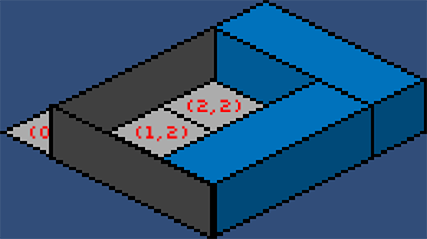
The screenshot shows the right way of sorting extended objects 3x1 and 1x3 with "fences" measuring 3x0 and 0x3
And that's where our troubles begin and put us in place where we have to decide on the way forward:
-
split "multi-celled" objects into "single-celled" ones, i.e. to cut it vertically and then sort the stripes emerged
-
think about the new sorting method, more complicated and interesting
I chose the second option, having no particular desire to get into tricky processing of every object, into cutting (even automatic), and special approach to logic. For the record, they used the first way in few famous games like Fallout 1 and Fallout 2. You can actually see those strips if you get into the games' data.
So, the second option doesn't imply any sorting criteria. It means that there is no pre-calculated value by which you could sort objects. If you don't believe me (and I guess many people who never worked with isometry don't), take a piece of paper and draw small objects measuring like 2x8 and, for example, 2x2. If you somehow manage to figure out a value for calculation its depth and sorting — just add a 8x2 object and try to sort them in different positions relative to one another.
So, there's no such value, but we still can use dependencies between them (roughly speaking, which one's overlapping which) for topological sorting. We can calculate the objects' dependencies by using projections of isometric coordinates on isometric axis.
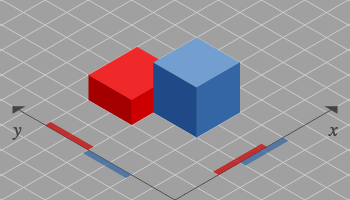
Screenshot shows the blue cube having dependency on the red one
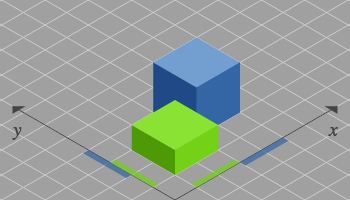
Screenshot shows the green cube having dependency on the blue one
A pseudocode for dependency determination for two axis (same works with Z-axis):
bool IsIsoObjectsDepends(IsoObject obj_a, IsoObject obj_b) {
var obj_a_max_size = obj_a.position + obj_a.size;
return
obj_b.position.x < obj_a_max_size.x &&
obj_b.position.y < obj_a_max_size.y;
}With such an approach we build dependencies between all the objects, passing among them recursively and marking the display Z coordinate. The method is quite universal, and, most importantly, it works. You can read detailed description of this algorithm, for example, here or here. Also they use this kind of approach in popular flash isometric library (as3isolib).
And everything was just great except that time complexity of this approach is O(N^2) since we've got to compare every object to every other one in order to create the dependencies. I've left optimization for later versions, having added only lazy re-sorting so that nothing would be sorted until something moves. So we're going to talk about optimization little bit later.
Editor extension
From now on, I had the following goals:
- sorting of objects had to work in the editor (not only in a game)
- there had to be another kind of Gizmos-Arrow (arrows for moving objects)
- optionally, there would be an alignment with tiles when object's moved
- sizes of tiles would be applied and set in the isometric world inspector automatically
- AABB objects are drawn according to their isometric sizes
- output of isometric coordinates in the object inspector, by changing which we would change the object's position in the game world
And all of these goals have been achieved. Unity really does allow to expand its editor considerably. You can add new tabs, windows, buttons, new fields in object inspector. If you want, you can even create a customized inspector for a component of the exact type you need. You can also output additional information in the editor's window (in my case, on AABB objects), and replace standard move gizmos of objects, too. The problem of sorting inside the editor was solved via this magic ExecuteInEditMode tag, which allows to run components of the object in editor mode, that is to do it the same way as in a game.
All of these were done, of course, not without difficulties and tricks of all kinds, but there was no single problem that I'd spent more than a couple of hours on (Google, forums and communities sure helped me to resolve all the issues arisen which were not mentioned in documentation).
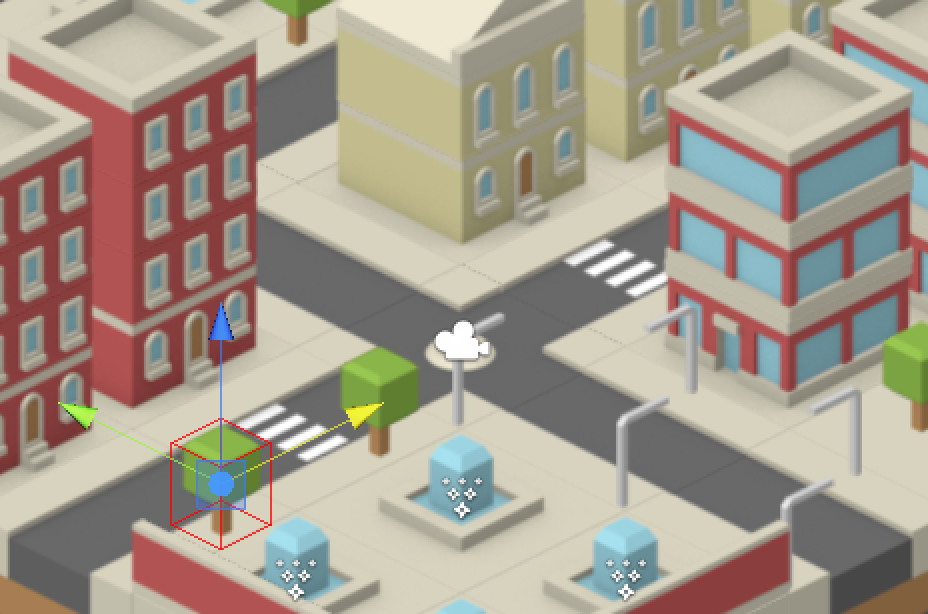
Screenshot shows my gizmos for movement objects within isometric world
Release
So, I got the first version ready, took the screenshot. I even drew an icon and wrote a description. It's time. So, I set a nominal price of $5, upload the plugin in the store and wait for it to be approved by Unity. I didn't think over the price much, since I didn't really want to earn big money yet. My purpose was to find out if there is a general demand and if it was, I would like to estimate it. Also I wanted to help developers of isometric games who somehow ended up absolutely deprived of opportunities and additions.
In 5 rather painful days (I spent about the same time writing the first version, but I knew what I was doing, without further wondering and overthinking, that gave me the higher speed in comparison with people who'd just started working with isometry) I got a response from Unity saying that the plugin was approved and I could already see it in the store, just as well as its zero (so far) sales. It checked in on the local forum, built Google Analytics into the plugin's page in the store and prepared myself to wait the grass to grow.
It didn't take very long before first sales, just as feedbacks on the forum and the store came up. For the remaining days of January 12 copies of my plugin have been sold, which I considered as a sign of the public's interest and decided to continue.
Optimization
So, I was unhappy with two things:
- Time complexity of sorting — O(N^2)
- Troubles with garbage collection and general performance
Algorithm
Having 100 objects and O(N^2) I had 10,000 iterations to make just to find dependencies, and also I'd have to pass all of them and mark the display Z for sorting. There should've been some solution for that. So, I tried a huge number of options, could not sleep thinking about this problem. Anyway, I'm not going to tell you about all the methods I've tried, but I'll describe the one that I've found the best so far.
First thing first, of course, we sort only visible objects. What it means is that we constantly need to be know what's in our shot. If there is any new object, we got to add it in the sorting process, and if one of the old one's gone — ignore it. Now, Unity doesn't allow to determine the object's Bounding Box together with its children in the scene tree. Pass over the children (every time, by the way, since they can be added and removed) wouldn't work — too slow. We also can't use OnBecameVisible and other events because these work only for parent objects. But we can get all Renderer components from the necessary object and its children. Of course, it doesn't sound like our best option, but I couldn't find another way, same universal and acceptable by performance.
List<Renderer> _tmpRenderers = new List<Renderer>();
bool IsIsoObjectVisible(IsoObject iso_object) {
iso_object.GetComponentsInChildren<Renderer>(_tmpRenderers);
for ( var i = 0; i < _tmpRenderers.Count; ++i ) {
if ( _tmpRenderers[i].isVisible ) {
return true;
}
}
return false;
}There is a little trick of using GetComponentsInChildren function that allows to get components without allocations in the necessary buffer, unlike another one that returns new array of components
Secondly, I still had to do something about O(N^2). I've tried a number of space splitting techniques before I stopped at a simple two-dimensional grid in the display space where I project my isometric objects. Every such sector contains a list of isometric objects that are crossing it. So, the idea is simple: if projections of the objects are not crossed, then there's no point in building dependencies between the objects at all. Then we pass over all visible objects and build dependencies only in the sectors where it's necessary, thereby lowering time complexity of the algorithm and increasing performance. We calculate the size of each sector as an average between the sizes of all objects. I found the result more than satisfying.
General performance
Of course, I could write a separate article on this… Okay, let's try to make this short. First, we're cashing the components (we use GetComponent to find them, which is not fast). I recommend everyone to be watch yourselves when working with anything that has to do with Update. You always have to bear in mind that it happens for every frame, so you've got to be really careful Also, remember about all interesting features like custom == operator. There are a lot to things to keep in mind, but in the end you get to know about every one of them in the built-in profiler. It makes it much easier to memorize and use them :)
Also you get to really understand the pain of garbage collector. Need higher performance? Then forget about anything that can allocate memory, which in C# (especially in old Mono compiler) can be done by anything, ranging from foreach(!) to emerging lambdas, let alone LINQ which is now prohibited for you even in the simplest cases. In the end instead of C# with its syntactic sugar you get a semblance of C with ridiculous capacities.
Here I'm gonna give some links on the topic you might find helpful:
Part1, Part2, Part3.
Results
I've never known anybody using this optimization technique before, so I was particularly glad to see the results. And if in the first versions it took literally 50 moving objects for the game to turn it into a slideshow, now it works pretty well even when there're 800 objects in a frame: everything's spinning at top speed and re-sorting for just for 3-6 ms which is very good for this number of objects in isometry. Moreover, after initialization it almost haven't allocate memory for a frame :)
Further opportunities
After I read feedbacks and suggestions, there were a few features which I added in the past versions.
2D/3D Mixture
Mixing 2D and 3D in isometric games is an interesting opportunity allowing to minimize drawing of different movement and rotations options (for instance, 3D models of animated characters). It's not really hard thing to do, but requires integration within the sorting system. All you need is to get a Bounding Box of the model with all its children, and then to move the model along the display Z by the box's width.
Bounds IsoObject3DBounds(IsoObject iso_object) {
var bounds = new Bounds();
iso_object.GetComponentsInChildren<Renderer>(_tmpRenderers);
if ( _tmpRenderers.Count > 0 ) {
bounds = _tmpRenderers[0].bounds;
for ( var i = 1; i < _tmpRenderers.Count; ++i ) {
bounds.Encapsulate(_tmpRenderers[i].bounds);
}
}
return bounds;
}that's an example of how you can get Bounding Box of the model with all its children
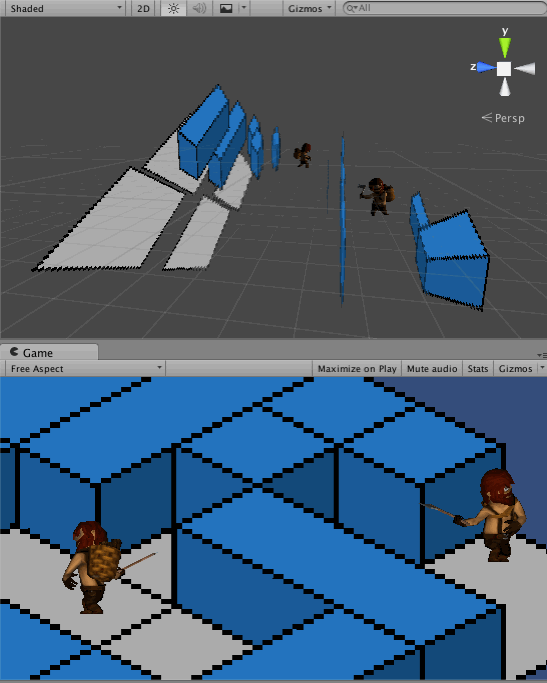
and that's what it looks like when it's done
Custom isometric settings
That is relatively simple. I was asked to make it possible to set the isometric angle, aspect ratio, tile height. After suffering some pain involved in maths, you get something like this:
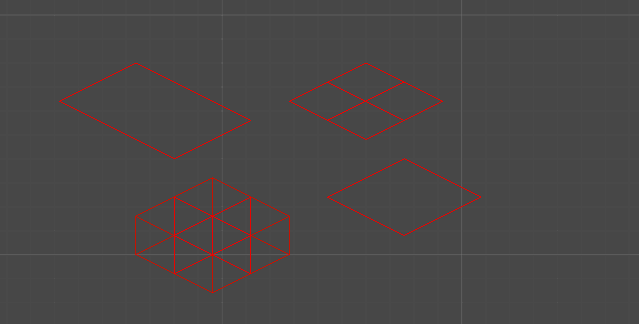
Physics
And here it gets more interesting. Since isometry simulates 3D world, physics is supposed to be three-dimensional, too, with height and everything. I came up with this fascinating trick. I replicate all the components of physics, such as Rigidbody, Collider and so on, for isometric world. According to these descriptions and setups I make the copy of invisible physical three-dimensional world using the engine itself and built-in PhysX. After that I take the simulation data calculated and get those bacl in duplicating components for isometric world. Then I do the same to simulate bumping and trigger events.
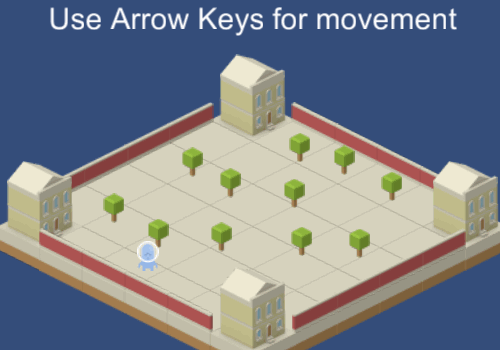
The toolset physical demo GIF
Epilogue and conclusions
After I implemented all the suggestions from the forum, I decided to raise the price up to 40 dollars, so it wouldn't look look like just another cheap plugin with five lines of code :) I will be very much delighted to answer questions and listen to your advices. Since it's the first time I'm writing something on Habr, I welcome all kinds of criticism, thank you! And now, something I was saving for last, the month's statistics of sales:
| Month | 5$ | 40$ |
|---|---|---|
| January | 12 | 0 |
| February | 22 | 0 |
| March | 17 | 0 |
| April | 9 | 0 |
| May | 9 | 0 |
| June | 9 | 0 |
| July | 7 | 4 |
| August | 0 | 4 |
| September | 0 | 5 |
Unity Asset Store page link: Isometric 2.5D Toolset
Автор: MATov

